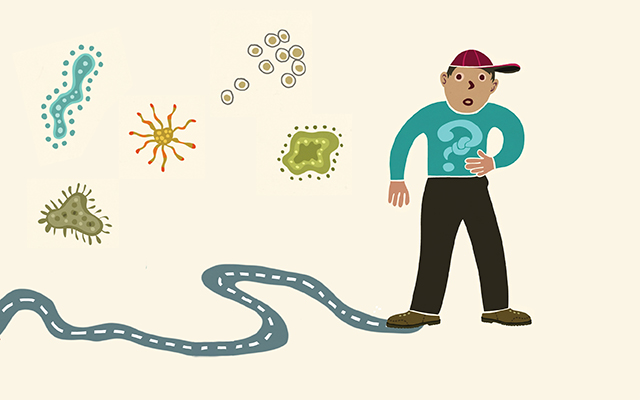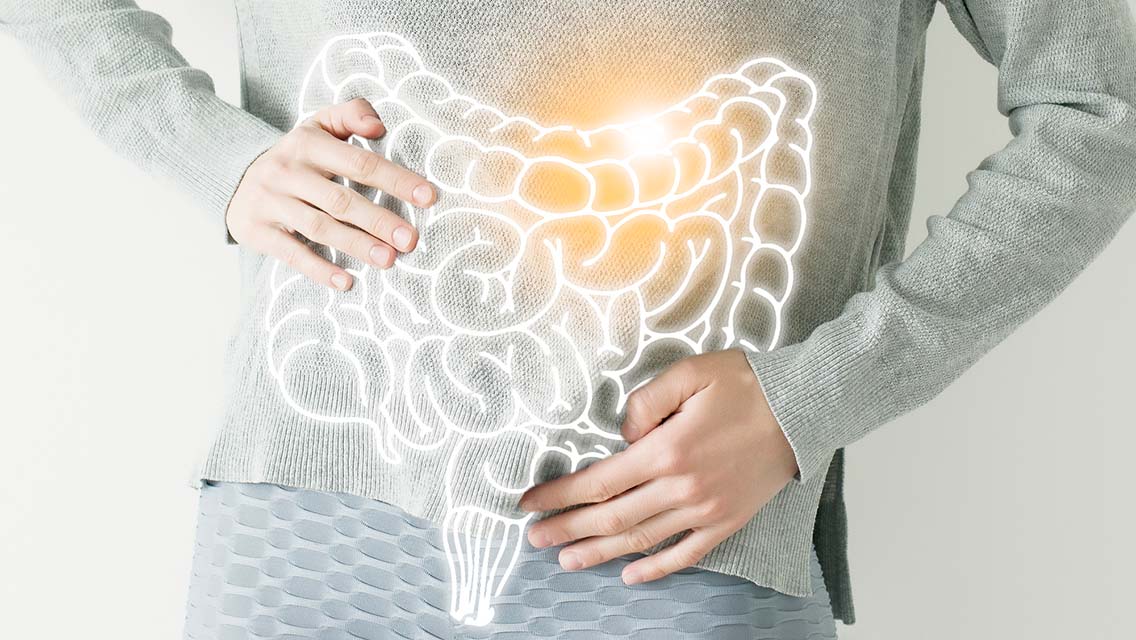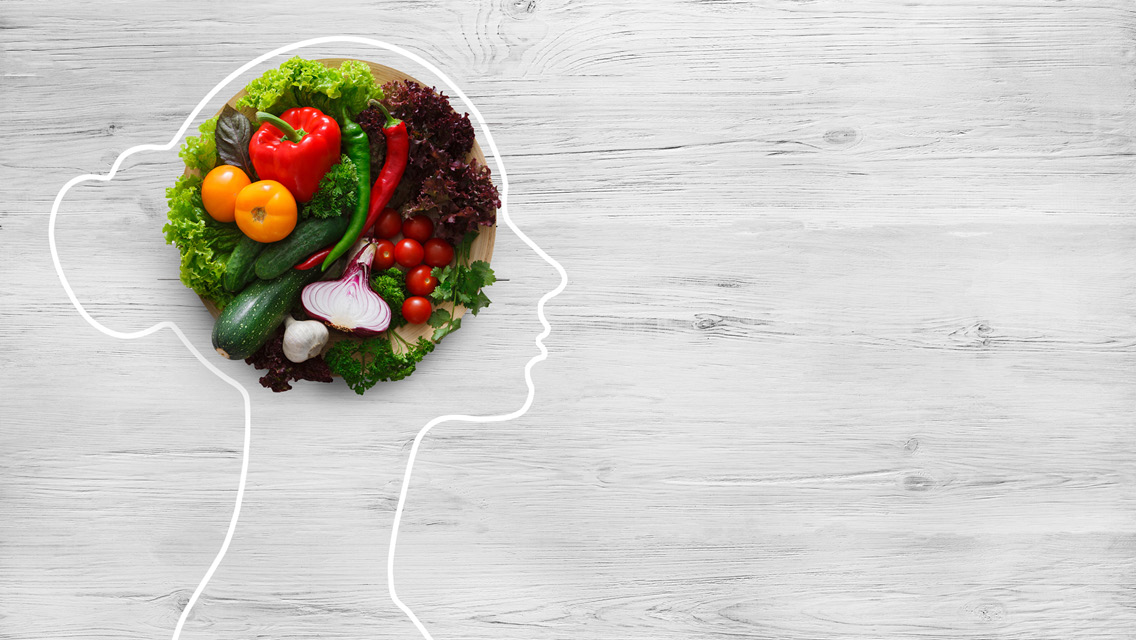For most of his life, Rich Geldreich suffered gut distress. The 42-year-old San Diego–based software engineer had experienced recurring bloating, gas, and constipation since he was 13. His symptoms grew more severe as he aged and were exacerbated by his stressful job.
“Every time I had a big deadline at work, I’d hit a wall with my gut,” he says. The pain and gas felt “like a volcano erupting.”
After one especially bad bout in 2013 triggered by severe food poisoning, Geldreich saw five doctors, including a gastroenterologist. They all offered the same diagnosis: irritable bowel syndrome (IBS).
This didn’t bring relief.
IBS affects one in five Americans, yet its causes are a mystery to most health professionals, even those who specialize in gastrointestinal (GI) disorders. Unlike a disease, which has identifiable biomarkers, a syndrome is a collection of common symptoms — and can be devilishly difficult to treat.
“IBS is the most common diagnosis made by gastroenterologists, yet it’s the one we know the least about,” says Robynne Chutkan, MD, an integrative gastroenterologist at Georgetown University Hospital. Part of the problem, she says, is that root causes can be as varied as the individuals suffering from them, and doctors often don’t take time to search them out.
“Stopping with a diagnosis of IBS is too vague,” Chutkan explains. “If you take a good look, you find lots of potential explanations — gluten sensitivity, parasites, bacterial overgrowth, lactose intolerance, and leaky gut. But none of those can really be addressed in your typical 15-minute appointment.”
Most physicians are taught to view gut ailments as a problem with anatomy, but IBS is usually about biology and function, says Greg Plotnikoff, MD, coauthor of Trust Your Gut. “IBS doesn’t lend itself to quantification; it won’t show up on a CT scan, an ultrasound, or a biopsy. So people with IBS get passed from doctor to doctor like a hot potato.”
Geldreich was one such hot potato. When he visited his doctors in 2015, each one put him through a variety of tests. They all ruled out ulcers, Crohn’s disease, and cancer. After no one found an explanation for his chronic pain, Geldreich went home with a prescription for heartburn medication and the suggestion that he start supplementing with probiotics.
Doctors write nearly 6 million prescriptions a year for drugs to ease IBS symptoms. Yet GI specialists agree that these medications — usually laxatives, antidiarrheals, and antispasmodics for cramping — often provide little relief.
“The drugs we use to treat IBS only have a 10 to 40 percent efficacy rate compared with placebo,” says University of Michigan gastroenterologist Shanti Eswaran, MD. And they often produce side effects that can compound IBS symptoms. The antacids Geldreich’s doctors prescribed, for example, can lead to reduced stomach acid and poorer digestion. (For more on problems with antacids, go to “Natural Ways to Fight Heartburn.”)
Leaving the underlying causes of IBS untreated takes a toll. By 2015 Geldreich developed gastritis, a painful inflammation of the gut lining, as well as small intestinal bacterial overgrowth (SIBO), which can cause bloating and nutrient malabsorption. He couldn’t sleep. He struggled to find foods he could eat, and his weight dropped from 150 to 115 pounds.
It was at this point, after meeting a stressful deadline at work, that Geldreich made up his mind. He took his bonus, quit his high-pressure job, and devoted himself full-time to getting to the root of his gut problems.
“I had no choice,” he says. “This was a battle for my life.”
The Path to Healing
While every case of IBS is different, most functional-treatment strategies cover the same basic protocol. These are the steps Geldreich followed in his recovery.
1. Know Your Gut’s History
IBS can seem like a lifetime diagnosis, but it doesn’t have to be — especially if you work with a health practitioner who helps you address the root causes.
“It’s absolutely essential to figure out why you have IBS, rather than just accept the diagnosis and resign yourself to a life of pharmaceutical intervention,” says Chutkan. “You have to be a medical detective.”
Geldreich enlisted the help of two Seattle healthcare providers: functional naturopath Dan Lukaczer, ND, and acupuncturist Avigail Cohen, LAc. Over the next 18 months, each would help him identify and treat the underlying causes of his IBS.
When he first met with Geldreich, Lukaczer asked for a detailed health history. “As a physician, I get a lot of clues from a patient’s story,” Lukaczer says. “Getting to the root cause of a condition like IBS isn’t like one of those medical TV shows, where you find out it’s one unusual thing, like the mercury from fish or lead from the pipes, that’s making a person sick. Usually it’s a combination of factors, and Rich is a good example of that complexity.”
“It’s absolutely essential to figure out why you have IBS, rather than just accept the diagnosis and resign yourself to a life of pharmaceutical intervention,” says Chutkan. “You have to be a medical detective.”
Their discussion revealed several potential causes for Geldreich’s distress. He told Lukaczer about his pressure-cooker job and how he often worked 12- to 14-hour days. He also recalled getting sick after drinking water contaminated with raw sewage when he was 13. (Hostile microbes are a common trigger for chronic gut ailments, and they can persist in the gut for years.) By the end of the 90-minute appointment, Geldreich felt hopeful.
“Lukaczer was the first doctor who I felt was actually paying attention,” he recalls.
Most IBS patients feel unheard and disempowered, says Plotnikoff. “Asking a patient to ‘tell me your story’ often shines a light on the most important information.”
Geldreich’s health history also revealed a family connection: Both his mother and his brother experienced gut distress. Studies show that people who have a parent or sibling with IBS are three times as likely to suffer from the condition, though it’s unclear precisely why or how.
“We know genes play a role in IBS,” says Gerard Mullin, MD, associate professor of medicine at The Johns Hopkins Hospital in Baltimore. But we don’t know exactly how or how much.
Both genetics and microbes have an influence. The microbiome is a pillar of gut health, so any inherent weakness ups the odds of a gut-related condition.
Meanwhile, the bulk of the 100 trillion microbiota that compose our gut microbiomes are inherited from our mothers, including some 1,000 species of bacteria and untold archaea, fungi, and viruses. This inher-it-ance is transferred from mother to baby in the birth canal. If a mother’s intestinal microbiota are imbalanced at the time of delivery, her child’s often are, too.
Studies have found that people with diarrhea-predominant IBS have lower-than-normal levels of Bifidobacterium and Lactobacillus; those with constipation-predominant IBS show flagging levels of Veillonella species.
While genes can’t be altered, the microbiome can be revitalized with nutritional and lifestyle interventions. A genetic predisposition is not a life sentence.
2. Balance the Microbiome
Like many people, Geldreich inherited a less-than-robust microbiome. And then life piled on.
For years he worked too much, rarely exercised, and ate a less-than-stellar diet: He often wolfed down energy bars for lunch and chain-restaurant fare for dinner. He’d taken multiple courses of antibiotics over the years, and Chutkan notes that a single course of a broad-spectrum antibiotic, such as ciprofloxacin (commonly prescribed for urinary- and respiratory-tract infections), can destroy up to a third of the gut’s good bacteria. “The process of repopulation may take months or even years,” she explains.
“Identifying and remediating the cause of bacterial imbalance is essential to repairing and healing the gut,” Chutkan adds. “Your microbiome wasn’t built in a day, so rebuilding it will be a gradual process. But tangible improvements can be made.” (For more on this, see “Build Your Microbiome.”)
For her IBS patients, Chutkan often advises a 90-day course of high-quality probiotics to repopulate the gut with good bacteria. She recommends a formula with strains of Bifidobacterium, Lactobacillus, and Strepto-coccus, which “help crowd out pathogenic species.
“Probiotics aren’t a panacea, but for those suffering from microbial discord, they represent a glimmer of real hope for improved health.”
“Probiotics aren’t a panacea,” she admits, “but for those suffering from microbial discord, they represent a glimmer of real hope for improved health.”
To get a glimpse of what was going on in his patient’s microbiome, Lukaczer reviewed the results of Geldreich’s comprehensive digestive stool analysis.
The results showed Geldreich was free of many of the parasites and yeasts common in people with IBS, though they did show he had difficulty digesting fats, which can lead to bloating, pain, and indigestion. Lukaczer put him on supplements containing fiber and bile salts to aid with fat absorption.
This allowed him to move forward to the next step of healing his gut’s lining.
3. Address Leaky Gut
In a healthy gut, the lining serves as a sophisticated filter. It’s composed of permeable cells that allow fully digested nutrients to pass through while deflecting larger food particles, chemicals, and toxins.
When those cells are -irritated — by food allergens, stress, toxins, and other sources — the cell junctures loosen and microscopic bits of undigested food leak into the bloodstream. The immune system attacks these invaders, leading to chronic inflammation that can perpetuate low-grade digestive discomfort for years. (For more, see “How to Heal a Leaky Gut.”)
Chronic inflammation is the long road to a leaky gut and IBS; the shortcut is intestinal infection. One in three cases of IBS begins with a severe bout of food poisoning or traveler’s diarrhea. The infection causes the immune system to target the gut directly. The resulting inflammation weakens the microbiome and, for some, unleashes IBS symptoms.
Geldreich took the long road and the short road. He had a family history of gut ills and a microbiome weakened by a childhood illness; then the bad bout of food poisoning in 2013 triggered his chronic gut distress. “After that, I was in near-constant stomach pain,” he says.
To heal a leaky gut, Chutkan follows the three Rs: remove, replace, and repair.
- Remove the major dietary sources of inflammation, including dairy, gluten, refined sugars, alcohol, and artificial sweeteners.
- Replace them with nutrient-rich vegetables and fermented foods, like sauerkraut and kefir.
- Repair by eating anti-inflammatory foods, such as gut-healing bone broth, cold-water fish, flaxseeds, and walnuts.
Lukaczer put Geldreich on a comprehensive elimination diet for three to four weeks that cut out gluten, dairy, soy, corn, beef, pork, sugar, and processed foods. (See “Nutrition Protocols to Relieve IBS,” opposite page.) This offered Geldreich substantial relief, as it does for many IBS sufferers whose guts have become leaky and, by extension, hypersensitive to inflammatory fare.
Lukaczer also started him on gut-healing supplements, including probiotics and digestive enzymes.
Onward
Geldreich left his job to escape the stressful work environment, though he knew unemployment was not a long-term solution. He worked with his healthcare providers to develop a supportive plan: In addition to maintaining good nutrition and stress management, he committed to exercising at least 30 minutes a day, retiring between 9 and 10 p.m. to optimize restorative sleep, and scheduling a weekly massage and chiropractic adjustment. He also started walking up to three miles daily.
Geldreich moved to San Diego for its sunny, laid-back atmosphere. He is once again employed as a tech consultant but now works from home. This allows him to eat well and take breaks to exercise. He walks every day, and as his health has improved, he’s started jogging and weightlifting. After following an elimination diet for several months and using a rigorous, food-and-supplement-based approach to rebuilding his gut lining, he now eats most foods comfortably. His IBS symptoms have been absent for a year.
“The human body has quite a bit of resiliency if we unleash it,” Lukaczer says. Though the symptoms of IBS once nearly ruled his life, Geldreich is now living proof that the gut, when given the tools and support it needs, is built to heal.
2 Nutrition Protocols to Relieve IBS
Food intolerances are common in people with IBS. While nutrition changes alone don’t usually cure all symptoms, food protocols that remove common irritants give the gut lining a chance to heal, creating a solid foundation for a healthy microbiome and a positive-feedback loop that supports overall gut health. These two approaches are commonly used to treat IBS.
1. Elimination Diets
A modified elimination diet involves removing one common food allergen from your diet for two to four weeks, and paying attention to the effects on your symptoms. Eliminating dairy is a good place for people with gut distress to start. About one in four Americans has some form of lactose intolerance, and some IBS patients enjoy at least partial remission when they give up dairy, says gastroenterologist Shanti Eswaran, MD. “This is the first thing to try.”
The second item to eliminate is gluten. Although celiac disease is rare, many people suffer from nonceliac gluten sensitivity. This can cause symptoms similar to celiac symptoms, such as bloating, gas, rashes, and brain fog, but it isn’t considered an autoimmune disease.
Because there is no specific diagnostic test for gluten sensitivity, the only way to check is to remove it and then reintroduce it. “Cut gluten for two to three weeks and see what happens,” says integrative gastroenterologist Robynne Chutkan, MD. “It is DIY medicine at its best. Chances are, you are going to feel better.” Gluten is found in wheat, rye, barley, and spelt.
A comprehensive protocol eliminates all the most common food allergens — dairy, gluten, yeast, eggs, corn, soy, and peanuts — for two to four weeks. If food sensitivities are triggering the IBS, relief should come quickly with this approach.
(For a guide to the Institute for Functional Medicine’s elimination diet, as well as instructions for reintroducing foods over time, visit ELmag.com/ifmdetox.)
2. Low-FODMAP Diet
FODMAP stands for fermentable oligosaccharides, disaccharides, monosaccharides, and polyols — foods that contain either simple or complex sugars that are fermented by bacteria in the small intestine and colon. As FODMAPs ferment, they release short-chain fatty acids and gas (mostly carbon dioxide and hydrogen). The gas stretches the bowel (a.k.a. intestine), which causes abdominal pain and bloating. Fructose, lactose, and polyols draw water into the bowel, which can worsen diarrhea.
The low-FODMAP diet restricts those fermentable foods and has provided relief to many IBS sufferers. It is probably the most challenging of all elimination diets because it removes otherwise healthy foods containing particular carbohydrates that can provoke gas and bloating.
The protocol has two phases. The first lasts two to four weeks and involves a strict elimination of all high-FODMAP foods, such as wheat; some vegetables (including onions, garlic, cabbage, and broccoli); some fruits (such as stone fruits, apples, and pears); sorbitol, which is often found in chewing gum and sugar-free foods; and dairy products containing lactose.
This strict avoidance phase is brief; it is a test to determine sensitivity. “The idea behind the low-FODMAP diet is that you won’t really know what you’re sensitive to unless you take everything out and see how you feel,” says -Eswaran. “This isn’t something you want to stay on long term.”
The second phase is a slow reintroduction of specific FODMAP foods to see which you can tolerate. For this phase, it’s important to work with a healthcare provider who is trained in the diet, says Eswaran. “The reintroduction process can take many weeks, and guidance is important to keep you from getting frustrated.”
Eswaran led a study of 90 IBS sufferers: Half followed a low-FODMAP diet and the other half took common-sense measures, such as eating smaller meals and cutting back on caffeine and alcohol. At the end of six weeks, more than 50 percent of the people on the low-FODMAP diet saw a major reduction in abdominal pain, compared with 20 percent in the control group.
The Role of The Gut-Brain Axis
How, exactly, do worry, anxiety, and general emotional stress relate to IBS? As researchers have discovered, the gut is a road to the brain — and it’s a two-way street.
The gut–brain axis refers to the biochemical signaling between the gut and brain, which takes place largely through the connecting channel of the vagus nerve.
The health of the brain and gut depend on each other, says Emeran Mayer, MD, PhD, codirector of CURE: Digestive Diseases Research Center at the University of California, Los Angeles. The healthier your mental state, the healthier the messages to the gut, and vice versa.
Stress increases stomach-acid production, which can cause heartburn and nausea. It channels blood away from the gut, which slows digestion and lowers nutrient absorption; it can also speed up or slow down elimination.
The gut’s microbes are separated from the intestine’s inner lining by a thin layer of mucus; from there, they pick up brain signals about how stressed, happy, sad, or anxious you are. At least 70 percent of the body’s mood-regulating serotonin is produced in the gut, where no less than seven different serotonin receptors are involved in everything, including peristalsis (the muscular action of the intestines during digestion), pain sensitivity, and mood. Because our microbes can signal to our brains and modulate emotions, it’s easy to imagine how a gut hijacked by bad bacteria can cause your mental health to nosedive, explains Mayer. (For more on the microbiome and mood, see “Psychobiotics: Using Gut Bacteria to Treat Mental Illness.”)
Stress increases stomach-acid production, notes Chutkan, which can cause heartburn and nausea. It channels blood away from the gut, which slows digestion and lowers nutrient absorption; it can also speed up or slow down elimination. Even for people with healthy guts, a stressful conversation during a meal can cause stomach upset.
A traumatic experience in early life may be another precursor. Studies have shown women with IBS often report a history of verbal, sexual, or physical abuse. Nearly twice as many women as men have IBS.
Other studies have found that hypervigilance and catastrophic thinking can amplify IBS symptoms.
Stress reduction is as important as a healthy diet in the treatment of IBS, if not more so, Mayer contends. “What starts as an emotion in the brain influences the activity of your gut and can alter the signals generated by your microbes. Some of these signals, in turn, communicate back to the brain, reinforcing and sometimes even prolonging the emotional state.”
When Good Bacteria Turn Bad
By Courtney Helgoe
Painful bloating after meals is common among IBS sufferers, and a frequent trigger for it is small intestinal bacterial overgrowth, or SIBO.
SIBO is “an overcolonization of specific bacteria, usually the colon bacteria, into the small intestine, where they don’t belong,” explains IBS researcher Mark Pimentel, MD, an associate professor of medicine at Cedars–Sinai in Los Angeles.
More than half of all patients with IBS also have SIBO, according to naturopaths Allison Siebecker, ND, MSOM, LAc, and Steven Sandberg-Lewis, ND, DHANP.
Unlike the large intestine, which is designed to host a large, diverse community of microbiota, a healthy small intestine is home to far fewer bacteria.
When microbes do colonize the small intestine, they feed vigorously on any carbohydrates they encounter.
This half-digested material ferments in the small intestine, producing hydrogen or methane gas that leads to bloating and discomfort. Bloating tends to get worse as the day goes on, and many people may feel the need to loosen their belts by evening, explains functional nutritionist Liz Lipski, PhD, CCN, CHN, author of Digestive Wellness.
Other symptoms of SIBO include flatulence, heartburn, nausea, and fatty stool or steatorrhea. A number of other health conditions are correlated with SIBO, including hypothyroidism, fibromyalgia, acne rosacea, celiac disease, and nonalcoholic fatty liver disease.
How do bacteria get into the small intestine?
Your digestive system keeps things moving thanks to the migrating motor complex (MMC), which transfers bacteria down into the lower intestine when the body is fasting between meals and at night. Anything that inhibits the MMC can allow bacteria to accumulate in the small bowel. Food poisoning, for example, may trigger gut neuropathy and stasis, leading to overgrowth. Even stress can disrupt the MMC, affecting the gut lining at the same time.
Another suspected cause of SIBO is deficient stomach acid, often from the overuse of antacids. “If you don’t have acid in your stomach protecting you from bacteria, fungi, and parasites coming in on your food, you are left wide open,” notes Lipski. Some health professionals suspect that problems with the colon’s microbiome can be a trigger; more research is still needed. Others believe that mechanical problems with the valve between the large and small intestines may cause bacteria to escape into the small bowel.
How is SIBO diagnosed?
The standard test for SIBO is a breath analysis that measures elevated hydrogen and methane, both byproducts of fermentation in the small intestine. (Excess hydrogen corresponds to diarrhea-predominant IBS; methane corresponds to constipation-dominant IBS.) The test is usually administered in a doctor’s office, but home kits are available.
Because tests tend to provide inconsistent results (both over- and under-diagnoses), many healthcare providers opt to treat SIBO symptoms without tests. According to functional-medicine practitioner Chris Kresser, MS, LAc, who sees many patients with IBS, “we have no gold-standard way of diagnosing SIBO.”
How is SIBO treated?
Because SIBO is a bacterial condition, the goal of treatment is to eradicate bacterial overgrowth. The usual protocol involves some combination of a carbohydrate-restrictive diet (like low-FODMAP) to starve the bacteria and either pharmaceutical or herbal antibiotics to eliminate them.
The standard antibiotic used is rifaximin, which works locally in the digestive system and causes fewer systemic effects.
Studies have found that herbal antibacterials — berberine, oregano, and others — perform as well as rifaximin. One herbal formula called Atrantil was developed based on research in reducing methane production in cattle.
Many find digestive supplements such as hydrochloric acid or herbal bitters helpful in reducing bacterial overload.
In general, while recovery is often slow and sometimes incomplete, many SIBO sufferers can find significant relief with these strategies within several weeks. The tendency for relapse is common; health professionals are still trying to figure out why.
This originally appeared as “Gut Feelings” in the January/February 2018 issue of Experience Life.




This Post Has 0 Comments